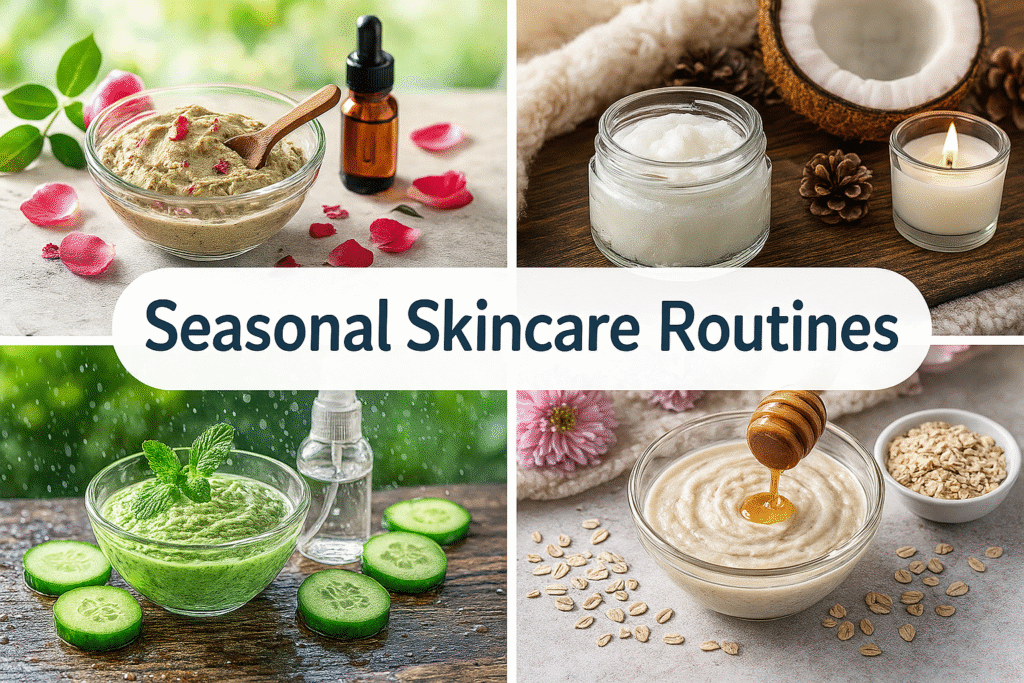
Every season tells a different story — not just for nature, but also for our skin. I’ve always felt that when the weather changes, my face starts speaking to me in its own little ways. In winter, it becomes dry and dull no matter how much cream I apply, and in summer, it feels sticky, sweaty, and lifeless. It took me a long time to realize that my skin doesn’t need expensive products or hundreds of steps — it just needs the right kind of care according to the season.
I still remember one winter morning when my skin was so dry that I didn’t even feel like looking in the mirror. My cheeks had lost their glow, and no moisturizer seemed to help. That’s when I turned to simple natural remedies — like warm coconut oil, milk cream (malai), and a spoon of honey. I used to apply them before bath, and slowly my skin started feeling alive again. That moment taught me that skincare isn’t about buying; it’s about understanding.
Every season affects our skin differently. In summer, we deal with heat and sweat; in winter, dryness takes over; and during monsoon, humidity clogs our pores. So, instead of using the same products all year, we need to change our routine just like we change our clothes with the weather.
In this post, I’m sharing my tried and tested seasonal skincare routines — from homemade DIY masks to simple natural toners that anyone can make at home. These are the things I actually use in my daily life, especially since I have dry skin. But I’ve also included easy options for oily, combination, and sensitive skin types — because every skin deserves love and care.
This isn’t a fancy beauty guide; it’s more like a warm conversation between you and me about how to care for your skin naturally, with things already lying in your kitchen. So grab a cup of tea, relax, and let’s explore how we can make our skin glow through every season — the natural way.
1. Dry Skin – Gentle Nourishment for Lifeless Skin
Dry skin has always been a part of my life — especially in winter, when the cold air steals away every bit of softness. There were days when I used to apply layer after layer of cream, yet my face still felt rough and stretched. Over time, I learned that dry skin doesn’t just need moisture; it needs care that goes deeper — something that nourishes and protects from within.
I’ve realized one simple truth: dry skin isn’t weak; it’s just thirsty. It needs hydration, oil balance, and gentle products that don’t strip its natural oils. Harsh soaps, hot showers, and skipping moisturizers make it worse. So instead of using store-bought creams that only work for a few hours, I started turning to natural ingredients — simple, pure, and effective.
Below are some of the homemade remedies I use throughout the year to keep my skin healthy, soft, and radiant. These DIYs are safe, affordable, and easy for anyone to try — especially if your skin gets dry or dull like mine.
1. Warm Coconut Oil Massage (Deep Hydration)
Whenever winter arrives, coconut oil becomes my skin’s best friend. I slightly warm a spoon of coconut oil between my palms and gently massage it on my face and neck in circular motions for 3–5 minutes. Then I leave it for about 20 minutes before washing with lukewarm water.
Why it works: Coconut oil is rich in fatty acids that deeply moisturize and heal flaky skin. It builds a natural barrier, locking in moisture even in harsh cold weather.
Tip: Use this twice a week at night. If your skin is extra dry, you can leave it on overnight.
Warm coconut oil in a small glass bowl with cotton pads and soft towel beside it.”
2. Banana and Honey Moisture Mask (Instant Softness)
On days when my skin feels lifeless, I mash half a ripe banana with one tablespoon of honey. I apply this smooth paste all over my face and keep it for 15 minutes before rinsing it off with cool water. The combination gives my skin a fresh, plump look almost instantly.
Why it works: Banana provides natural oils and potassium that soften rough patches, while honey attracts and retains moisture.
Tip: Apply once or twice a week for a healthy glow. It’s perfect before special occasions or if your skin feels tired. Mashed banana and honey in a small ceramic bowl with a wooden spatula.
3. Milk Cream (Malai) Treatment (Natural Glow)
This is one of the oldest and simplest tricks I learned from my mother. I apply a thin layer of fresh malai on my face and leave it for 10 minutes, then rinse with lukewarm water. It instantly brings back shine and smoothness.
Why it works: Milk cream contains lactic acid that gently removes dead cells and nourishes the skin with healthy fats.
Tip: If you’re allergic to dairy, replace malai with almond milk cream.
(A small bowl of fresh malai placed on a wooden tray with rose petals.)
4. Rose Water and Aloe Hydration Toner (Freshness Booster)
After cleansing, I mix equal parts rose water and aloe vera gel, store it in a spray bottle, and mist my face twice daily. It refreshes my skin and helps me feel more confident even on makeup-free days.
Why it works: Rose water tones and calms the skin, while aloe soothes dryness and irritation.
Tip: Keep the spray bottle in the fridge for extra cooling during summer.
(A glass spray bottle filled with rose water and aloe gel beside rose petals.)
My Personal Experience
Ever since I started following these small routines, my skin has transformed. I no longer feel that rough tightness after washing my face. Instead, my skin feels comfortable, nourished, and more alive. The best part? I don’t rely on expensive products anymore — everything I use comes straight from nature and my kitchen.
Taking care of dry skin is not about hiding flaws; it’s about bringing back its natural beauty. I’ve learned that when I care for my skin gently, it rewards me with confidence. And that, to me, is real glow — not from makeup, but from self-care and love.
2. Oily Skin – Stay Fresh, Not Sticky
If you have oily skin, you know how frustrating it can feel — that constant shine on your forehead, the sticky nose, and how makeup just melts away after a few hours. I’ve seen this struggle up close. My cousin, for example, always said she felt like washing her face every two hours during summer. But when she started understanding her skin, everything changed.
Oily skin isn’t bad; it’s just overprotective. It produces more sebum (natural oil) than needed, thinking it’s keeping you safe from dryness. But too much oil can clog pores, cause pimples, and make your face look greasy. The trick is not to remove the oil completely, but to balance it — keeping the good moisture and controlling the extra shine.
Below are a few easy, effective, and skin-safe DIY remedies that keep oily skin clean, matte, and healthy — without making it dry or irritated.
1. Multani Mitti (Fuller’s Earth) Face Pack – Oil Control Hero
This one is a summer must-have. I usually suggest this to anyone with oily skin because it’s simple and effective. Take two tablespoons of Multani mitti, add one teaspoon of rose water, and mix until it becomes a smooth paste. Apply evenly on your face and let it dry for 10–15 minutes. Wash off with cool water.
Why it works: Multani mitti absorbs extra oil, unclogs pores, and cools down the skin naturally. It gives a fresh, oil-free look that lasts long.
Tip: Use twice a week. Avoid using daily, as it might make your skin too dry.
(A small clay bowl with Multani mitti paste and rose petals beside it.)
2. Lemon and Honey Cleanser – Natural Brightener
If you want your skin to feel fresh and clean after a long day, this combo works beautifully. Mix one teaspoon of lemon juice with one teaspoon of honey and apply gently on your face. Leave it for 10 minutes, then rinse with lukewarm water.
Why it works: Lemon helps reduce excess oil and lightens scars, while honey balances the skin so it doesn’t feel stripped.
Tip: Always do a patch test first. If you have sensitive skin, dilute lemon with a few drops of rose water.
(A honey dipper dripping honey into a small bowl of lemon juice.)
3. Aloe Vera and Tea Tree Gel – Acne & Shine Control
Aloe vera is one of the best ingredients for oily skin. Mix one tablespoon of fresh aloe vera gel with 2–3 drops of tea tree oil. Apply a thin layer on your face before sleeping and leave it overnight.
Why it works: Aloe hydrates the skin without greasiness, and tea tree oil kills acne-causing bacteria and reduces inflammation.
Tip: Use 2–3 times a week at night. Keep it in the fridge for a soothing feel.
(A glass bowl of aloe gel with a few tea tree leaves beside it.)
4. Cucumber and Yogurt Refreshing Pack – Pore Tightener
This remedy works wonders after long, hot days. Blend half a cucumber with two tablespoons of yogurt and apply for 15 minutes. Rinse with cold water.
Why it works: Cucumber cools and shrinks pores, while yogurt gently exfoliates and controls oil.
Tip: Use this 2–3 times a week, especially during summer afternoons.
My Personal Reflection
Watching my cousin’s oily skin transformation taught me something powerful — oily skin isn’t a problem; it’s just misunderstood. Once she replaced harsh soaps with mild cleansers and added natural packs like Multani mitti and aloe, her skin started glowing naturally. The oiliness reduced, and so did her acne.
Sometimes we think we need to “dry out” oily skin, but that’s a mistake. When the skin loses moisture, it produces even more oil to protect itself. So the goal is balance, not dryness.
Oily skin, when cared for properly, looks radiant, smooth, and youthful for years. It’s naturally less prone to wrinkles too! So, instead of fighting it, just listen to it — give it cooling, cleansing, and light nourishment.
When you feel confident about your skin, you stop comparing yourself to others. You realize that healthy skin isn’t about being perfect; it’s about feeling clean, fresh, and comfortable in your own texture.
3. Combination Skin – Balancing the Best of Both Worlds
Some mornings, your cheeks feel dry and tight, but by afternoon, your forehead and nose start shining — if this sounds like you, you probably have combination skin. It’s one of the most common and misunderstood skin types. It feels confusing because one part of your face wants hydration, while another begs for oil control. I often say that combination skin is like a little reminder from nature that balance is beautiful — not just for the skin, but for life too.
When I first started learning about skincare, I thought everyone’s skin behaved the same. I used to follow random routines I saw online — sometimes moisturizing too much, sometimes using oil-control packs daily. The result? My skin got confused too! That’s when I realized that every face tells its own story, and if you really want your skin to glow, you have to listen to it.
My Experience
I remember my college friend, Sonal , who struggled with combination skin for years. She would apply heavy moisturizers during winter, and her T-zone (forehead, nose, and chin) would become shiny within an hour. But if she skipped moisturizing, her cheeks looked dull and flaky. She kept switching products, hoping to “fix” her skin — but the real solution came only when she simplified her routine.
I still remember the day she tried a simple homemade pack with oatmeal and honey. After washing it off, she looked into the mirror and said, “My skin finally feels normal.” That line stuck with me — because that’s what combination skin really needs: balance.
Understanding Combination Skin
Combination skin usually has:
- An oily T-zone (forehead, nose, chin) due to active oil glands.
- Dry or normal cheeks, which can feel tight or flaky.
- Visible pores in the oily area but smooth skin elsewhere.
It can change slightly with the weather — during summer, it feels oilier; in winter, it leans toward dryness. So, one constant routine doesn’t always work. What works best is seasonal balance — light hydration, mild cleansing, and gentle exfoliation.
When you care for combination skin, you don’t need to overload it with products. Nature already gives you what you need — in your kitchen!
1. Oatmeal and Honey Gentle Scrub – Smooths and Balances
Take one tablespoon of oatmeal powder and one teaspoon of honey. Mix with a few drops of rose water to make a soft paste. Gently massage it on your face for 2–3 minutes, especially on the oily T-zone. Leave it for another 5 minutes before washing off with lukewarm water.
💬 Why it works: Oatmeal absorbs extra oil without drying, while honey keeps the dry areas soft and nourished.
💡 Tip: Use it twice a week. It’s gentle enough for both oily and dry parts of your face.
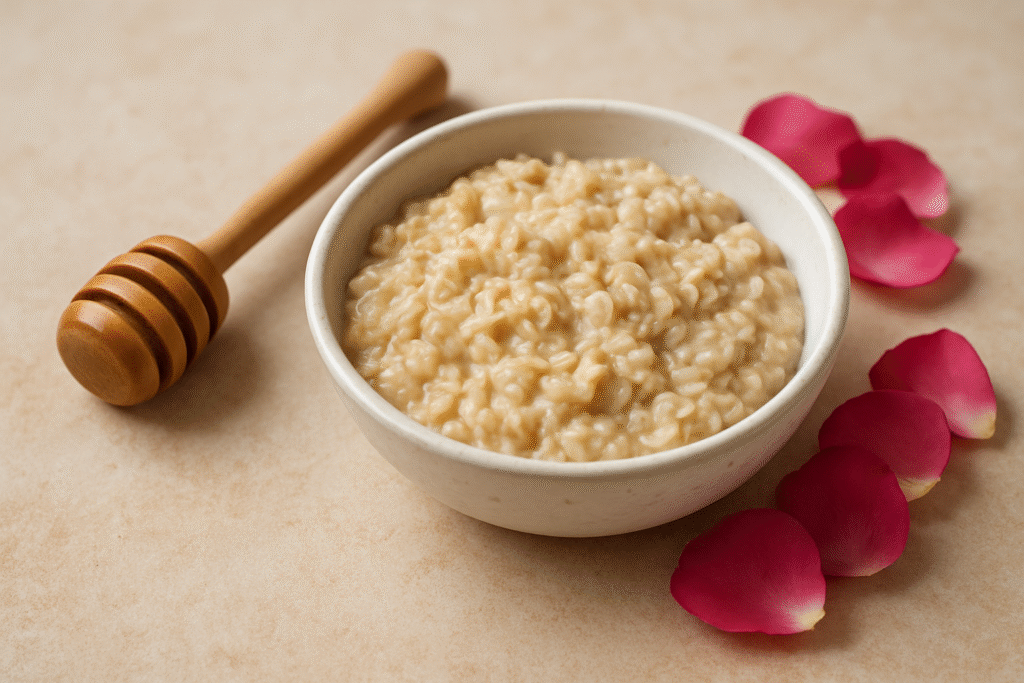
2. Aloe Vera and Cucumber Gel Mask – The Balancing Duo
Blend half a cucumber and mix with two tablespoons of aloe vera gel. Apply evenly over your face and leave it on for 15–20 minutes. Rinse with cool water.
💬 Why it works: Cucumber cools and tightens pores, while aloe vera hydrates dry areas without adding greasiness.
Tip: Keep this mask in the fridge for a refreshing, spa-like experience — perfect for hot days!
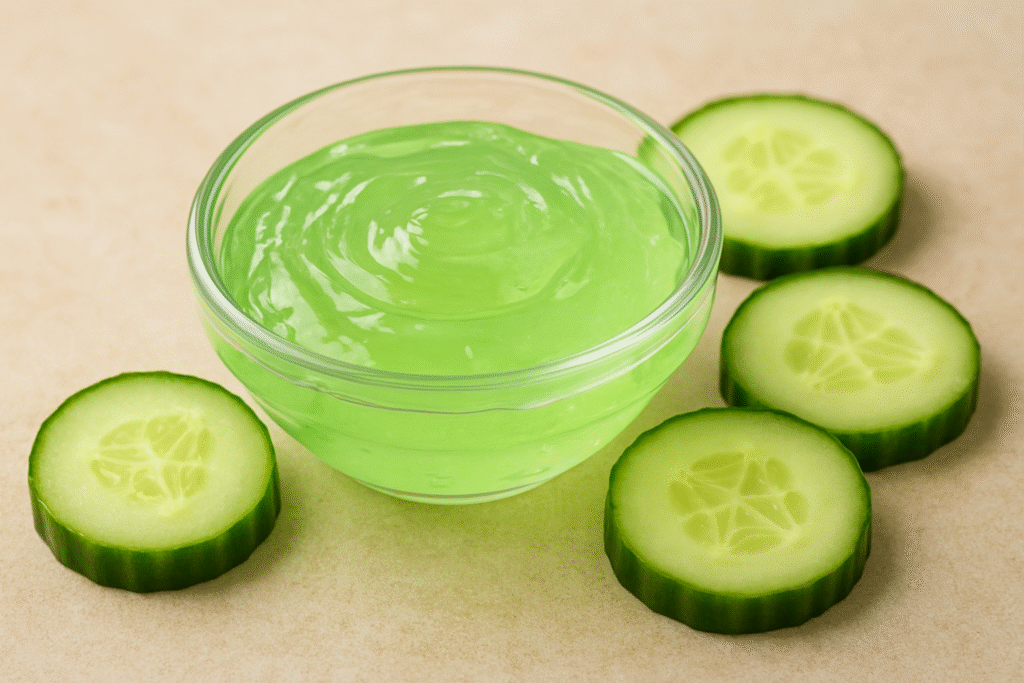
3. Yogurt and Gram Flour (Besan) Pack – Natural Cleanser & Glow Enhancer
Mix one tablespoon of yogurt with one tablespoon of gram flour and a few drops of rose water. Apply a thin layer over your face and let it dry for 10–12 minutes. Wash with normal water.
💬 Why it works: Yogurt exfoliates gently and hydrates, while gram flour removes dirt and oil — giving an even, glowing texture.
Tip: Use once a week. It’s perfect before going out or when your skin feels uneven.
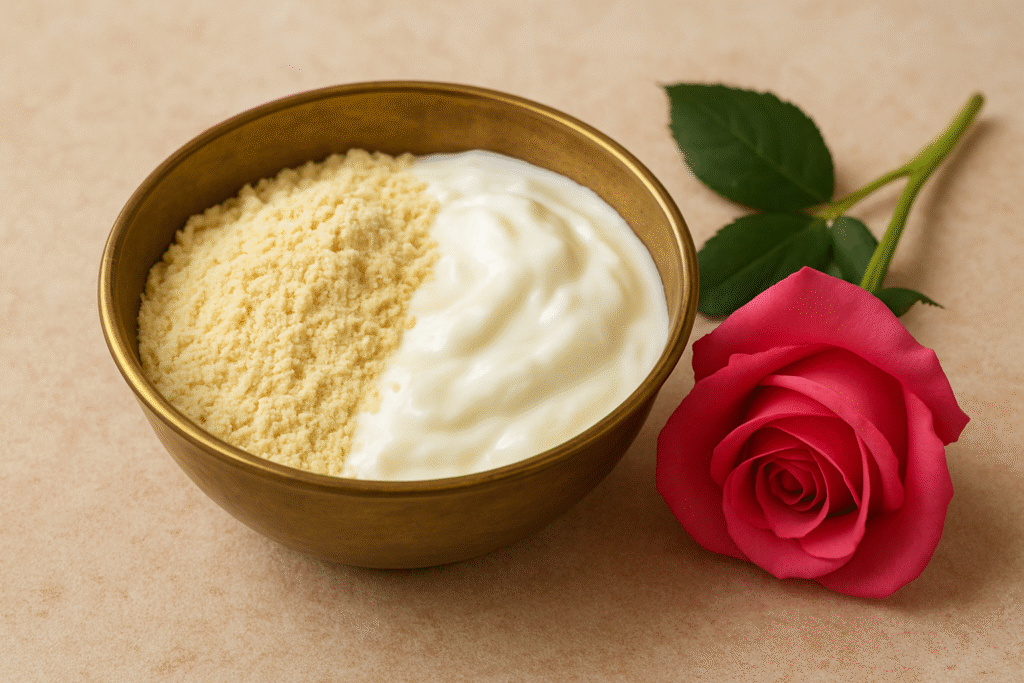
My Reflection
Combination skin teaches us balance — not just for our face, but in life too. It reminds us that too much of anything, even care, can harm. I’ve noticed that people with this skin type often feel they have to “fix” it, but really, it just needs gentle understanding.
When my friend Rashi started following a simple routine — mild cleanser, aloe-cucumber gel, and a light natural moisturizer — her skin began to feel normal again. The oily parts calmed down, and the dry areas regained their glow. It took a few weeks, but the results felt real and lasting.
One of the biggest mistakes we make is thinking one product will suit our whole face. The truth is, our skin is as unique as we are. So listen to it — some areas may crave hydration, while others just need freshness. Once you learn to care for both, your skin naturally starts looking healthy and confident.
Combination skin, when balanced, has the best of both worlds — the glow of oily skin and the softness of dry skin. You don’t need to hide it; you just need to understand it.
Sensitive Skin – Calm, Soothe & Protect Naturally
Understanding the Heart of Sensitive Skin
Living with sensitive skin feels like walking on thin ice. One wrong product, a change in soap, or even a windy day can turn a calm face into red patches, tiny rashes, or an itchy irritation that stays longer than you wish. I still remember the first time I realized my skin reacts so quickly. I had applied a new moisturizer one winter morning, and within ten minutes my cheeks started burning. It wasn’t a serious reaction, but it made me so conscious that for the next few months I didn’t try anything new. Sensitive skin teaches you to listen carefully—it speaks softly at first, through a tingle or tightness, and if we ignore it, it screams with redness.
People with sensitive skin often feel left out when everyone talks about glowing skincare routines full of actives and acids. The truth is, we need a different rhythm—slow, gentle, and patient. Our skin loves balance more than anything fancy. The secret is not to fight with it but to comfort it, just like how you’d calm a crying child—with softness, patience, and warmth.
How Weather Affects Sensitive Skin
Each season brings a new challenge. In summer, the heat and sweat open pores and make our skin react to dust, sun, and pollution. The face feels warm to touch, and small red bumps or heat rashes may appear around the nose and cheeks. Monsoon adds humidity, which traps sweat and sometimes causes fungal irritation or tiny acne that hurt when touched. Then comes winter, where cold air and low humidity strip away natural oils, leaving the skin dry, tight, and flaky.
When the seasons change, sensitive skin needs time to adjust—just like our body takes time to adapt to new weather. That’s why switching all your skincare products overnight is never a good idea. Introduce changes slowly. Use minimal ingredients and natural textures your skin already knows and trusts.
I’ve learned through trial and error that consistency is more powerful than any expensive cream. Even simple steps—like using a mild cleanser, applying a soft cotton towel instead of rubbing harshly, and keeping a little water bottle handy to stay hydrated—make a huge difference.
Daily Routine for Sensitive Skin
Morning Care
When you wake up, rinse your face with cool or slightly lukewarm water. Avoid hot water completely; it weakens the protective barrier of your skin. Use a gentle cleanser—one that doesn’t foam too much. After cleansing, pat dry softly (never rub).
Next, spritz a light, natural toner like rose water or chamomile water. It refreshes and balances the skin. Then, apply a mild moisturizer that locks moisture without making your skin heavy. Choose one with ingredients like aloe vera or oat milk—both are known to soothe irritation.
Finally, never skip sunscreen, even on cloudy days. Sensitive skin gets sunburned faster because the outer layer is thinner. Choose a mineral-based sunscreen with zinc oxide or titanium dioxide, which protects without stinging.
Evening Care
Evening time is for repair. Use micellar water or coconut-based cleansing milk to remove dirt gently. After cleansing, apply a calming serum or oil—something your skin already loves. Many people with sensitive skin find sweet-almond oil, squalane, or rose-hip oil comforting. Massage slowly using fingertips; the warmth of your fingers helps the product absorb better.
Once or twice a week, give your skin a rest night—no products, just clean and moisturized skin to breathe naturally.
Season-Wise Care Tips
🌤️ Summer – Cool & Protect
In summer, focus on keeping your skin cool and hydrated. Avoid alcohol-based toners or strong scrubs; they’ll only trigger irritation. Instead, use chilled rose water mist and lightweight gels. Wear cotton scarves or wide hats when stepping out.
At night, you can apply a thin layer of aloe vera gel mixed with rose water—it calms sun-stressed skin beautifully. If you sweat easily, wash your face with plain water 3–4 times a day instead of using soaps repeatedly.
If you want detailed DIYs for soothing summer skin, check out my post [DIY Natural Remedies for Sensitive Skin → link here] where I’ve shared cooling masks using cucumber, aloe, and chamomile.
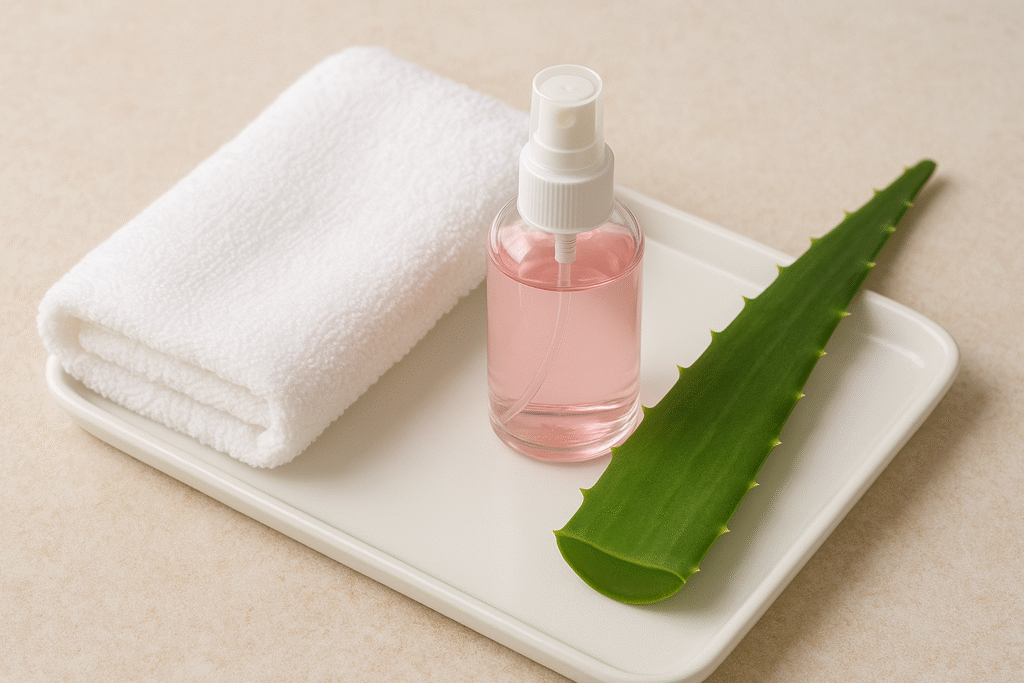
Monsoon – Breathe & Balance
During monsoon, humidity increases oil production and creates the perfect environment for breakouts. Use a light foaming cleanser that removes excess oil without making your face dry. You can add a mild natural exfoliation once a week using ground oats and honey—nothing too rough.
Always keep your towels clean and dry because damp fabrics carry bacteria that easily irritate sensitive skin. Avoid heavy creams during this season; instead, use gel-based moisturizers or light serums.
One simple habit that works wonders is washing your pillow covers twice a week. I learned this when my skin suddenly started breaking out every monsoon. The cause wasn’t any product—it was my pillowcase collecting moisture!
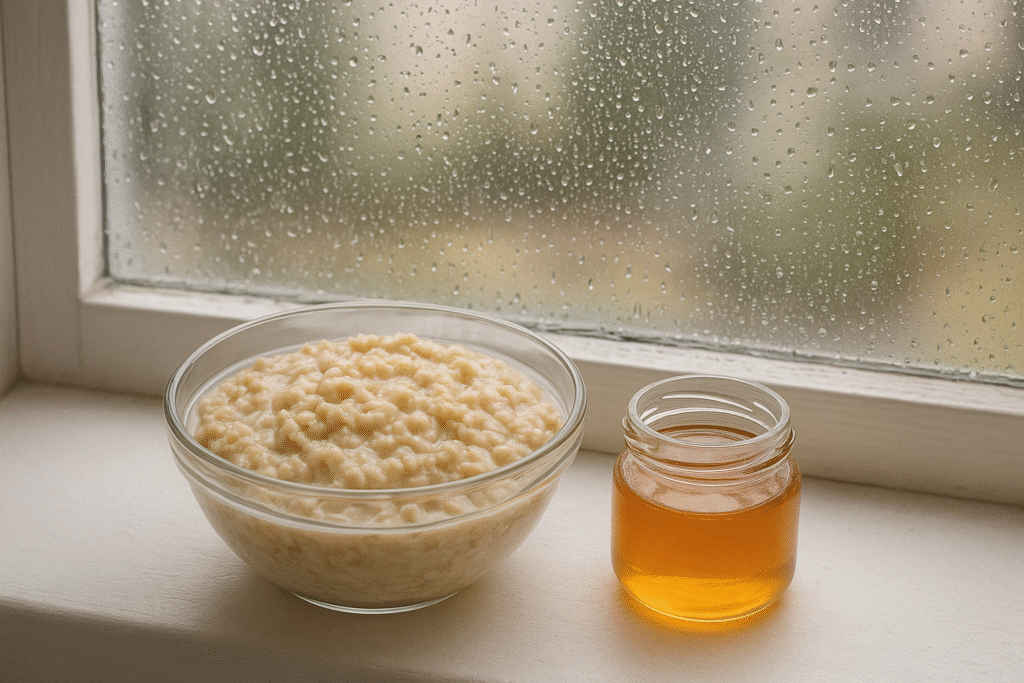
Winter – Nourish & Protect
Winter is when sensitive skin feels most helpless. The cold air outside and room heaters inside both steal moisture. Your skin may feel itchy, flaky, or even develop small cracks. This is when you should switch to a thicker moisturizer. I personally use coconut oil in winters—it has always worked like magic for me. I apply a few drops after a bath on slightly damp skin, so it locks moisture inside.
Use a creamy face wash instead of a gel one. Avoid long, hot showers; they feel good for a moment but make dryness worse later. Keep a bowl of water in your room or a humidifier—it balances air moisture and prevents your skin from feeling tight.
Before sleeping, you can apply a mix of coconut oil and a little aloe vera gel. It forms a natural protective layer that heals overnight.
If you want to see the step-by-step process, visit my post [DIY Winter Masks for Sensitive Skin → link here], where I’ve shared gentle packs using milk, oats, and coconut.
What to Avoid for Sensitive Skin
- Harsh Exfoliants: Skip scrubs with walnut shells or salt. They create micro-cuts that make sensitivity worse.
- Strong Fragrances: Even natural essential oils like peppermint or citrus can sting; always patch test first.
- Over-Layering Products: More products don’t mean better results. Stick to fewer but safer ones.
- Frequent Switching: Give your skin time to adapt—change one product at a time and observe for a week.
- Stress and Lack of Sleep: They may sound unrelated, but stress hormones make skin reactive. Deep breathing, meditation, and enough water often calm skin better than any cream.
Gentle Home Habits That Help
- Always patch test new ingredients on your wrist before using them on your face.
- Use soft cotton towels and change them every few days.
- Keep hydrated. Sensitive skin reacts faster when the body is dehydrated.
- Eat balanced food: Fruits, nuts, and green vegetables add internal strength to your skin barrier.
- Sleep enough. Seven hours of rest helps skin rebuild naturally overnight.
My Personal Experience & Lesson
Sensitive skin has taught me patience more than anything else. There were days I felt embarrassed to step out because my face had red patches or dry flakes. I used to hide behind scarves and avoid eye contact. But slowly, I realized that my skin was only asking for kindness. When I started listening—stopped using harsh scrubs, added coconut oil in winter, switched to simple rose water toner—things began to change.
Now, when my skin feels irritated, I don’t panic; I simplify. I drink more water, sleep early, and use my homemade aloe and rose mist. It’s a small routine, but it makes me feel in control again.
Sensitive skin might look delicate, but it’s actually strong—it heals beautifully when treated with care. It’s like a gentle flower: if you give it the right soil, water, and sunlight, it blooms quietly but gracefully.
If you’ve ever felt frustrated about your skin reacting to everything, remember—you’re not alone. Many of us have been through that same mirror moment where we wish our skin could just behave. But beauty is not about having perfect skin; it’s about having peaceful skin.
Through the seasons—summer, monsoon, and winter—our skin simply mirrors how we treat it. When you feed it water, protect it from the sun, and comfort it when it’s irritated, it thanks you with softness and glow.
Sensitive skin doesn’t limit you; it just asks for understanding. The more gentle you are, the stronger it becomes. So, take a deep breath, smile, and give your skin the love it deserves.
Leave a Reply